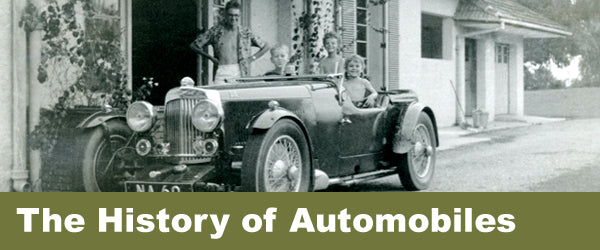
Posted by The Home School in the Woods Team on
Many people wonder who invented the first automobile. However, with the history of automobiles being so full, and designs for a self-propelled vehicle dating back to the 15th century, the answer isn’t that straightforward!
There’s a long list of people who have contributed to the invention of the automobile (not to mention the countless types of automobiles – from steam to electric and gas).
Buckle up as we take you through a brief history of the automobile and options for hands-on history materials to help teach your child about the remarkable evolution of cars!
What is an Automobile?
So, what exactly is an automobile?
It may seem silly to define the word automobile, but it’s an important place to start since the question of who invented the first car can be a matter of opinion.
By definition, an automobile or car is “a wheeled vehicle that carries its own motor and transports passengers.” With this in mind, we can skip past the age of wagons and fast forward to the time when man, engine, and transportation meet!
When Was the First Car Made?
Designs for a self-propelled vehicle were first drawn up in the 15th century by famous inventors like Leonard da Vinci and Issac Newton. However, it wasn’t until the steam engine was invented in 1698 that a motor-powered vehicle seemed within reach.
Nicolas-Joseph Cugno of France was the first person to build a self-propelled road vehicle in 1769. Cungo’s tractor-like car, which was intended for military purposes, was powered by burning fuel that heated water. Its steam would turn the crankshaft, and as a result, the wheels.
His three-wheeled automobile traveled at a whopping speed of 2.5 mph and could carry four passengers at a time. Unfortunately, the vehicle needed to be stopped every 10-15 minutes to build up enough steam power. It was also heavy and proved to be a poor design for a road vehicle.
Many historians consider Cugno to be the inventor of the first automobile. However, others disagree. Nonetheless, Cungo’s tractor influenced many others to follow suit, as 40 percent of American automobiles were still powered by steam at the beginning of the 20th century.
The Age of Electric
Before there were gas cars, there were electric cars! With so many unfixable complications with the steam engine, inventors knew there was a better way to build a lighter car with minimal maintenance and less noise.
The electric carriage was invented by Robert Anderson in Scotland around 1832-1839 and continued to be a popular energy choice up until the 20th century. However, because of the lack of charging stations and the rise of gasoline-powered automobiles, electric-powered cars were soon forgotten.
When Did Gas Cars Become Common?
Karl Friedrich Benz of Germany is credited for inventing the first practical automobile in 1885-86. His gasoline-powered automobile, powered by an internal combustion engine, would revolutionize transportation.
Other inventors quickly learned that gasoline-powered cars were the way to go as they could travel long distances, were easy to maintain, and were fueled by a cheap and widely available energy source.
Around the same time, German engineers Gottlieb Wilhelm Daimler and Wilhelm Maybach built the first four-wheeled car, and by 1893, Charles Edgar Duryea and his brother Frank were the first to open a gasoline-powered car manufacturer in Springfield, Massachusetts – later followed by Henry Ford, who made the first car accessible to the masses, the Model T, in 1908.
Ford’s effort to mass-produce cars was successful, with over 15 million Model Ts sold between 1913 and 1927. To learn more about industrialist Henry Ford and his world-changing invention, read our blog post, Henry Ford’s Model T Goes on Sale for the First Time.
By the 1920s, the “Big Three” auto companies, Ford, General Motors, and Chrysler, dominated the mass-production automobile industry, eventually expanding to Japan, that has been the leading automaker since 1980.
Adding the History of Automobiles to Your Curriculum
As you can see, the history of the automobile isn’t credited to a single person or day (in fact, it’s estimated that over 100,000 patents helped create the cars we drive today!). With that said, wrapping your head around this messy timeline can be confusing. That’s why we have a few resources to help.
For starters, we cover the invention of the automobiles and their impact on America in our Industrial Revolution Through the Great Depression study. We also cover various automobile elements in our timeline figures, such as Henry Ford and the Model T.
These materials are perfect for visual learners who need names and dates clearly mapped out in front of them. We can’t tell you how many testimonies we’ve received from homeschool parents on how timelines helped their kids better understand and enjoy history!
For more information on how you can teach your kids about transportation through the ages using timelines, check out our blog post, Teaching with Timelines.
Well, there you have it – the history of automobiles! If you enjoyed this post, be sure to “like” our Facebook page for more articles from our Transportation Through the Ages series!

Thank you for your dedication to this historical homeschool endeavor. Just discovered your page and am so excited to share all of this with my children this year!!